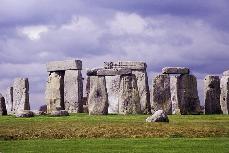Recent excavations of nine Neolithic houses at Durrington Walls near Stonehenge are leading archaeologists to formulate new theories as to what role the 4,600-year-old megalithic monument held in its day. The village is thought to have housed the builders of Stonehenge during its construction. There is also evidence to suggest the village served as a prominent center for ceremony adjunct to Stonehenge, attracting Neolithic peoples from all across southern England and perhaps other parts of Europe as well.
These claims are supported, archaeologists from the University of Sheffield say, by not only the village’s proximity to Stonehenge, but by the discovery of roads in each location that lead to the River Avon, linking the two locations together as part of a greater religious complex.
“Stonehenge isn’t a monument in isolation. It is one of a pair – one in stone, one in timber,” said Mike Parker Pearson, leader of the University of Sheffield excavation team to National Geographic News.
Also, correlations have been found between the layouts of each site, as Stonehenge faces the midsummer sunrise, while Durrington Walls faces the midwinter sunrise. Further, Stonehenge’s circle is aligned with the winter solstice sunset, while the remnants of a large timber circle discovered at Durrington appears to have been oriented with the winter solstice sunrise.
Archaeologists and historians can hardly overlook these parallels. Although relatively little is known about the culture of the Neolithic peoples of Britain, it is understood that celestial bodies held some significance in their practice of religion and ritual.
With that inference in mind, many archaeologists believe that the village was probably only occupied during these times of seasonal worship, when its alignment with the sun would provide ideal ritual conditions.
“This is where they went to party,” said Pearson to BBC news. “You could say it was the first free festival.”
According to Pearson, the findings at Durrington Walls force reconsideration of common perceptions of the conventional Stone Age village, as there is little evidence to support that the people there were involved in any form of daily economic or agricultural activity.
“There are a few tools for scraping hides and that sort of thing. But it’s completely different from any other Neolithic settlement assemblage we’ve ever looked at before,” said Pearson to National Geographic News.
“The animal bones are being thrown away half-eaten. It’s what we call a feasting assemblage,” said Pearson to BBC news.
What has been found are little chunks of flint resembling both male and female genitalia, which may have been used as charms in a kind of fertility ritual. The Sheffield team believes that a key part of the ritual may have been to travel down the River Avon from the village to Stonehenge, where ancestors would be consulted for fertility advice. The river may have also been used to transport the dead from the village to Stonehenge for burial, as skeletal remains at the site suggest.
“We think of the river as a conduit to the underworld,” said Pearson to National Geographic News.
The reigning interpretation held by most archaeologists is that the village upstream at Durrington with its wooden circle represents the land of the living, while the ageless monoliths of Stonehenge downstream stand sentry over the realm of the dead.
Archaeologist and broadcaster Julian Richards is among the small margin that have reservations about this theory.
“I see Stonehenge as a living monument, so in terms of broad understanding of the landscape, I’m not in total agreement,” Richards said to BBC news.
However, according to Tim Kircher, chair of the history department, the Sheffield archaeological team might not have come to their respective conclusion if it was not for a little help from a friend.
“One of the interesting features of this story is that the theory that Stonehenge was a burial site came from an anthropologist from Madagascar (named Ramilisonina), he wasn’t British,” said Kircher, testifying to the principle that sometimes in order to understand one culture, it helps to look at another.
“Ramilisonina is an expert in Malagasy ancestor worship, and it was he who suggested to the British archaeologists that the stones of Stonehenge were designed for ancestor worship because they represent eternity.

